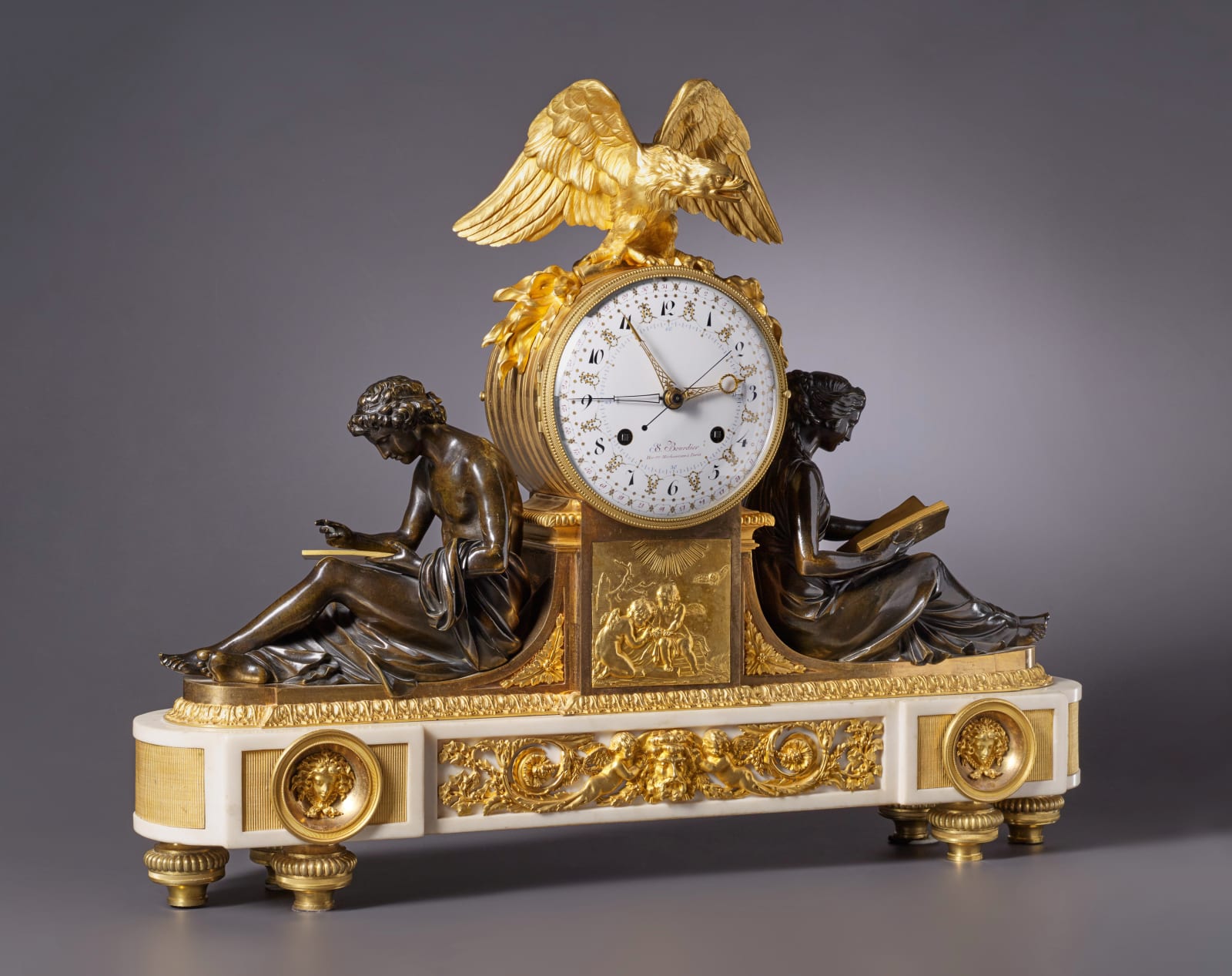Jean-Simon Bourdier
Literature
Cedric Jagger, "Royal Clocks", 1983, pp. 154 and 155, illustrating similar clock cases with movements by Lepine and Nicholas Sotiau, in the British royal collection.
Hans Ottomeyer and Peter Pröschel, "Vergoldete Bronzen", 1986, p. 295, pl. 4.17.5, illustrating a design for a similar case of 1785 from the Catalogue of François Rémond; and pl. 4.17.6, illustrating a very similar case by Rémond.
Pierre Kjellberg, "Encyclopédie de la Pendule Française du Moyen Age au Xxe Siècle", 1997, pp. 260 and 261, illustrating two other similar cases both with dials painted by Dubuisson.
A very important and rare Louis XVI patinated and gilt bronze and marble figural clock of fourteen day duration signed on the beautifully painted white enamel dial by the eminent clock maker Jean-Simon Bourdier Horloger Mechanicien à Paris and also signed by the renowned Parisian enameller Dubuisson. The exceptionally fine painted and gilded dial with the rare feature of inner sweep centre seconds, Arabic numerals for the hours, gilded indications for the minutes and outer Arabic numerals for the 31 days of the month. With beautiful pierced gilt brass hands for the hours and minutes and blued steel hands for the seconds and days of the month.
The magnificent patinated and gilt bronze case by François Rémond (b.circa 1747, d.1812) after models by the leading sculptor, Louis-Simon Boizot (1743-1809), surmounted by an eagle with thunder bolt striking from under his claws. With dial supported on a gilded pedestal with bas-relief depicting two putti with bird, on either side are two seated classical figures symbolising Learning and Philosophy, the young man to the left with writing implements and the young woman to the right reading a book. On a rectangular marble base with rounded ends ornamented with a central gilded frieze depicting an Apollo mask bordered by putti and foliate scrolls, with two outer Medusa medallions, supported on six gadrooned feet. The very large movement with pin-wheel escapement, spring suspension, striking on the hour and half hour on a single bell
Paris, date circa 1790
Height 54 cm, width 70 cm, depth 15 cm.
François Rémond made this magnificent figural case, after models in biscuit porcelain by Louis-Simon Boizot for the Sèvres factory. It was probably at the instigation of Madame du Berry that Boizot was appointed director of the sculpture studio at Sèvres in 1773. He remained there until 1800, during which time he made over 150 models of which this is among his most successful. Another highly celebrated case by him is the 'Avignon' clock, executed by Pierre Gouthière (1732-1813/4) in 1771 in the Wallace Collection, London.
Several versions of this clock can be found in important collections including at least three in the British royal collection, another at Château Versailles (illustrated in Ottomeyer and Pröschel (op.cit), p. 568, pl. 6). Other examples are owned by the Hermitage St. Petersburg, Musée de l'Ile-de-France, Château de Sceaux and at Stockholm Castle. The marchand-mercier, Dominique Daguerre commissioned a very similar case with movement by Nicholas Sotiau for the Salon des Jeux at Saint-Cloud. The model enjoyed a revival during the Empire when Napoleon commissioned a number as gifts of appreciation for his marshals.
The esteemed Parisian clockmaker and Horloger-Mécanicien, Jean-Simon Bourdier made the movement. He became a maître-horloger in 1787 establishing himself at Quai de l'Horloge until about 1806 when he moved to Rue Mazarine. Bourdier made a number of complex clocks; some with astronomics and equation of time as well as those fitted with flutes and singing birds. His clocks were housed in the finest and most elaborate cases suitable to furnish a number of royal palaces. There are at least seven of his clocks in the Patrimonio Nacional, Madrid, while other examples of his work can be found at the Musée de Dijon and in Paris at the Conservatoire des Arts et Métiers and the Ministère de la Guerre. One of his finest pieces was exhibited at The Richard Redding Gallery in 1994.



